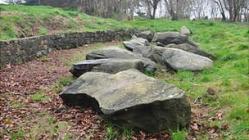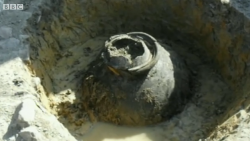INSTITUT SUPERIEUR D'ANTHROPOLOGIE
INSTITUTE OF ANTHROPOLOGY
ONLINE COURSES / COURS A DISTANCE
OPEN COURSE : FEBRUARY 2013
HRM 104 : INTRODUCTION TO INTANGIBLE CULTURAL HERITAGE
REGISTER NOW
IRLANDE –  Carrick on Suir - A hoard of 81 gold coins dating from the 17th century that was found by builders working on a Carrick-on-Suir town centre pub has been hailed by the National Museum of Ireland as one of the most significant discoveries of its kind ever in Ireland. The coins, dating as far back as 1630, were unearthed around 12 noon on Monday, January 14 by construction workers employed by building contractor Shane Comerford from Breanormore, Grangemockler while they were digging out a hole to lay a concrete pad in the front bar area of the pub that has been closed for the past three years. The coins were laid in a line together and the National Museum believes they may have been wrapped and held together by some material in the past that has not survived. The find consists of 81 gold coins dating to the reigns of Charles II, James II, William and Mary and William III. A National Museum spokesperson said no comparable 17th century hoard of gold coins has been found in Ireland since the discovery in Portarlington, Co. Laois, around 1947, of a hoard that contained little over 100 gold coins as well as some silver coins. According to the National Museum, the coins have yet to be examined in detail but they appear to be mainly Guineas and a small number of half Guineas. The Guinea was a British gold coin minted by the Royal Mint between 1663 and 1814 and they were called ‘Guineas’ because the gold used in making some of them came from West Africa. The site was investigated by archaeologists from the National Museum of Ireland and the National Monuments Service last week.
Carrick on Suir - A hoard of 81 gold coins dating from the 17th century that was found by builders working on a Carrick-on-Suir town centre pub has been hailed by the National Museum of Ireland as one of the most significant discoveries of its kind ever in Ireland. The coins, dating as far back as 1630, were unearthed around 12 noon on Monday, January 14 by construction workers employed by building contractor Shane Comerford from Breanormore, Grangemockler while they were digging out a hole to lay a concrete pad in the front bar area of the pub that has been closed for the past three years. The coins were laid in a line together and the National Museum believes they may have been wrapped and held together by some material in the past that has not survived. The find consists of 81 gold coins dating to the reigns of Charles II, James II, William and Mary and William III. A National Museum spokesperson said no comparable 17th century hoard of gold coins has been found in Ireland since the discovery in Portarlington, Co. Laois, around 1947, of a hoard that contained little over 100 gold coins as well as some silver coins. According to the National Museum, the coins have yet to be examined in detail but they appear to be mainly Guineas and a small number of half Guineas. The Guinea was a British gold coin minted by the Royal Mint between 1663 and 1814 and they were called ‘Guineas’ because the gold used in making some of them came from West Africa. The site was investigated by archaeologists from the National Museum of Ireland and the National Monuments Service last week.
http://www.nationalist.ie/news/local/gold-coin-hoard-found-in-carrick-on-suir-pub-1-4733967
ITALIE –  Naples - A report published by the Corriere della Sera earlier this month revealed the alarming state of much of Naple’s cultural heritage. The report speaks of neglect and mismanagement by the local and national authorities, which led to the closure and abandonment of around 200 churches in the city. Some of these churches have been looted, some never received the necessary funds for their conservation, while others did receive them but never proceeded to the agreed projects, or closed for restoration but never opened again. Naples has the largest historic centre in Europe. In 1995, it was listed by UNSECO as a World Heritage Site. It seems this acknowledgement is only valid on paper, as the city’s residents pointed out in a petition that circulated at the end of last year calling for the city to be stripped of its Unesco title! The petition was signed by 16 civic committees and 60 leading intellectual figures. It claimed that the city did nothing to protect its treasures. It included photographs documenting the neglect throughout the city, that was symbolically presented by the group during Unesco’s 40th anniversary conference at the city’s Federico II University.
Naples - A report published by the Corriere della Sera earlier this month revealed the alarming state of much of Naple’s cultural heritage. The report speaks of neglect and mismanagement by the local and national authorities, which led to the closure and abandonment of around 200 churches in the city. Some of these churches have been looted, some never received the necessary funds for their conservation, while others did receive them but never proceeded to the agreed projects, or closed for restoration but never opened again. Naples has the largest historic centre in Europe. In 1995, it was listed by UNSECO as a World Heritage Site. It seems this acknowledgement is only valid on paper, as the city’s residents pointed out in a petition that circulated at the end of last year calling for the city to be stripped of its Unesco title! The petition was signed by 16 civic committees and 60 leading intellectual figures. It claimed that the city did nothing to protect its treasures. It included photographs documenting the neglect throughout the city, that was symbolically presented by the group during Unesco’s 40th anniversary conference at the city’s Federico II University.
http://www.archaiologia.gr/en/blog/2013/01/30/200-closed-and-abandoned-churches-in-naples/
USA –  Clovis - Comet explosions did not end the prehistoric human culture, known as Clovis, in North America 13,000 years ago, according to research published in the journal Geophysical Monograph Series. Researchers from Royal Holloway university, together with Sandia National Laboratories and 13 other universities across the United States and Europe, have found evidence which rebuts the belief that a large impact or airburst caused a significant and abrupt change to the Earth's climate and terminated the Clovis culture. They argue that other explanations must be found for the apparent disappearance. Clovis is the name archaeologists have given to the earliest well-established human culture in the North American continent. It is named after the town in New Mexico, where distinct stone tools were found in the 1920s and 1930s. Researchers argue that no appropriately sized impact craters from that time period have been discovered, and no shocked material or any other features of impact have been found in sediments. They also found that samples presented in support of the impact hypothesis were contaminated with modern material and that no physics model can support the theory. "The theory has reached zombie status," said Professor Andrew Scott from the Department of Earth Sciences at Royal Holloway. "Whenever we are able to show flaws and think it is dead, it reappears with new, equally unsatisfactory, arguments. "Hopefully new versions of the theory will be more carefully examined before they are published".
Clovis - Comet explosions did not end the prehistoric human culture, known as Clovis, in North America 13,000 years ago, according to research published in the journal Geophysical Monograph Series. Researchers from Royal Holloway university, together with Sandia National Laboratories and 13 other universities across the United States and Europe, have found evidence which rebuts the belief that a large impact or airburst caused a significant and abrupt change to the Earth's climate and terminated the Clovis culture. They argue that other explanations must be found for the apparent disappearance. Clovis is the name archaeologists have given to the earliest well-established human culture in the North American continent. It is named after the town in New Mexico, where distinct stone tools were found in the 1920s and 1930s. Researchers argue that no appropriately sized impact craters from that time period have been discovered, and no shocked material or any other features of impact have been found in sediments. They also found that samples presented in support of the impact hypothesis were contaminated with modern material and that no physics model can support the theory. "The theory has reached zombie status," said Professor Andrew Scott from the Department of Earth Sciences at Royal Holloway. "Whenever we are able to show flaws and think it is dead, it reappears with new, equally unsatisfactory, arguments. "Hopefully new versions of the theory will be more carefully examined before they are published".
http://www.eurekalert.org/pub_releases/2013-01/rhuo-phn013013.php
ROYAUME UNI – 
 Guernesey - A Neolithic grave in Guernsey could be half-buried in soil and grassed-over to preserve it. Guernsey Museums and Art Galleries has asked for planning permission to conduct the work in Delancey Park and put up an information sign. States Archaeologist Dr Philip de Jersey said covering part of the stones would hopefully protect them. He said: "People have lit fires in between them so they crack... there's been graffiti... we want to stop that." The grave was discovered and excavated in 1919, 1932 and in the summers from 2009-2011.
Guernesey - A Neolithic grave in Guernsey could be half-buried in soil and grassed-over to preserve it. Guernsey Museums and Art Galleries has asked for planning permission to conduct the work in Delancey Park and put up an information sign. States Archaeologist Dr Philip de Jersey said covering part of the stones would hopefully protect them. He said: "People have lit fires in between them so they crack... there's been graffiti... we want to stop that." The grave was discovered and excavated in 1919, 1932 and in the summers from 2009-2011.
http://www.bbc.co.uk/news/world-europe-guernsey-21211846
ROYAUME UNI –  Wiltshire - Some of Wiltshire's most important archaeological sites are being targeted by thieves with metal detectors, according to police and English Heritage. They said ancient relics buried around Iron Age hill forts, are believed to have been taken by the so-called "nighthawks".
Wiltshire - Some of Wiltshire's most important archaeological sites are being targeted by thieves with metal detectors, according to police and English Heritage. They said ancient relics buried around Iron Age hill forts, are believed to have been taken by the so-called "nighthawks".
VIDEO = http://www.bbc.co.uk/news/uk-england-wiltshire-21252389